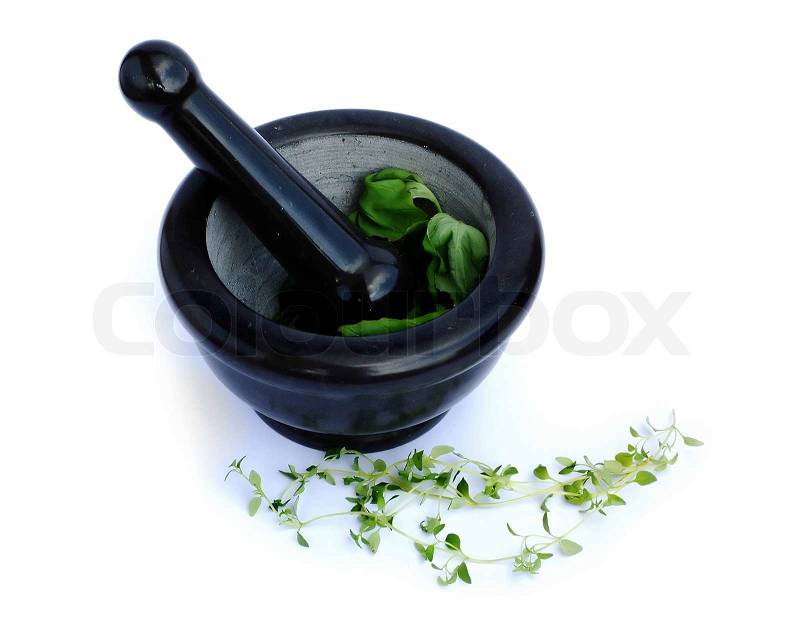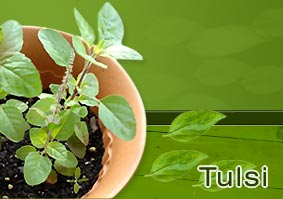Tulsi, Thulasi, Holy Basil, Ocimum Tenuiflorum is a aromatic plant or potent herb, that has been used in India for thousands of
years to treat colds, coughs, and flu. According to Ayurveda, tulsi
promotes purity and lightness in the body, cleansing the respiratory
tract of toxins and relieving digestive gas and bloating. Tulsi leaves
offer a rich source of essential oil, containing eugenol, nerol,
camphor, and a variety of terpenes and flavonoids. The oil is a strong
antiseptic against many kinds of disease-causing organisms, including
bacteria, fungi, and parasites.
Tulsi has spiritual as well as medicinal significance in Ayurveda. In Hindu mythology, the plant is an incarnation of the goddess Tulsi, offering divine protection. Many Indian families keep a living Tulsi plant in their homes tending to it with great care and reverence. The plant’s woody stalks are often made into beads used in meditation malas or rosaries.
Tulsi or tulasi is a sacred plant for Hindus and is worshiped by Hindus as the avatar of goddess Lakshmi. Water mixed with the petals is given to the dying to raise their departing souls to heaven. Tulsi, which is Sanskrit for "the incomparable one", is most often regarded as a consort of Krishna in the form of Lakshmi. According to the Brahma Vaivarta Purana, tulsi is an expression of Sita. There are two types of tulsi worshiped in Hinduism: "Rama tulsi" has light green leaves and is larger in size; "Shyama tulsi" has dark green leaves and is important for the worship of Hanuman. Many Hindus have tulsi plants growing in front of or near their home, often in special pots. Traditionally, tulsi is planted in the center of the central courtyard of Hindu houses. It is also frequently grown next to Hanuman temples, especially in Varanasi
According to Vaishnavas, it is believed in Puranas that during Samudra Manthana when the gods win the ocean-churning against asuras, Dhanvantari comes up from the ocean with Amrita in hand for the gods. Dhanvantari (the divine medico) sheds happy tears and when the first drop falls in Amrita it forms Tulasi. In the ceremony of Tulsi Vivah, tulsi is ceremonially married to Krishna annually on the eleventh day of the waxing moon or twelfth of the month of Kartika in the lunar calendar. This day also marks the end of the four-month Cāturmāsya period, which is considered inauspicious for weddings and other rituals, so the day inaugurates the annual marriage season in India. The ritual lighting of lamps each evening during Kartika includes the worship of the tulsi plant, which is held to be auspicious for the home. Vaishnavas especially follow the daily worship of tulsi during Kartika.
Vaishnavs traditionally use japa malas made from tulsi stems or roots, which are an important symbol of initiation. Tulsi malas are considered to be auspicious for the wearer, and believed to put them under the protection of Hanuman. They have such a strong association with Vaishnavas, that followers of Hanuman are known as "those who bear the tulasi round the neck". Sabarimla pilgrims are wearing Tulsi Mala when they starts their fasting and up to the end of the pilgrim day.
Tulsi has been used for thousands of years in Ayurveda for its diverse healing properties. It is mentioned in the Charaka Samhita, an ancient Ayurvedic text. Tulsi is considered to be an adaptogen, balancing different processes in the body, and helpful for adapting to stress. Marked by its strong aroma and astringent taste, it is regarded in Ayurveda as a kind of "elixir of life" and believed to promote longevity. Tulsi extracts are used in ayurvedic remedies for a variety of ailments.
Traditionally, tulsi is taken in many forms: as herbal tea, dried powder, fresh leaf or mixed with ghee. Essential oil extracted from Karpoora tulsi is mostly used for medicinal purposes and in herbal cosmetics, and is widely used in skin preparations. For centuries, the dried leaves of Tulsi have been mixed with stored grains to repel insects.
The variety of Tulsi used in Thai cuisine is referred to as Thai holy basil (กะเพรา kaphrao); it is not to be confused with Thai basil, which is a variety of Ocimum basilicum. The leaves of holy basil, known as kaphrao in the Thai language (กะเพรา), are commonly used in Thai cuisine. Kaphrao should not be confused with horapha (โหระพา), which is normally known as Thai basil, or with Thai lemon basil (maenglak; แมงลัก).
Tulsi has spiritual as well as medicinal significance in Ayurveda. In Hindu mythology, the plant is an incarnation of the goddess Tulsi, offering divine protection. Many Indian families keep a living Tulsi plant in their homes tending to it with great care and reverence. The plant’s woody stalks are often made into beads used in meditation malas or rosaries.
Tulsi or tulasi is a sacred plant for Hindus and is worshiped by Hindus as the avatar of goddess Lakshmi. Water mixed with the petals is given to the dying to raise their departing souls to heaven. Tulsi, which is Sanskrit for "the incomparable one", is most often regarded as a consort of Krishna in the form of Lakshmi. According to the Brahma Vaivarta Purana, tulsi is an expression of Sita. There are two types of tulsi worshiped in Hinduism: "Rama tulsi" has light green leaves and is larger in size; "Shyama tulsi" has dark green leaves and is important for the worship of Hanuman. Many Hindus have tulsi plants growing in front of or near their home, often in special pots. Traditionally, tulsi is planted in the center of the central courtyard of Hindu houses. It is also frequently grown next to Hanuman temples, especially in Varanasi
According to Vaishnavas, it is believed in Puranas that during Samudra Manthana when the gods win the ocean-churning against asuras, Dhanvantari comes up from the ocean with Amrita in hand for the gods. Dhanvantari (the divine medico) sheds happy tears and when the first drop falls in Amrita it forms Tulasi. In the ceremony of Tulsi Vivah, tulsi is ceremonially married to Krishna annually on the eleventh day of the waxing moon or twelfth of the month of Kartika in the lunar calendar. This day also marks the end of the four-month Cāturmāsya period, which is considered inauspicious for weddings and other rituals, so the day inaugurates the annual marriage season in India. The ritual lighting of lamps each evening during Kartika includes the worship of the tulsi plant, which is held to be auspicious for the home. Vaishnavas especially follow the daily worship of tulsi during Kartika.
Vaishnavs traditionally use japa malas made from tulsi stems or roots, which are an important symbol of initiation. Tulsi malas are considered to be auspicious for the wearer, and believed to put them under the protection of Hanuman. They have such a strong association with Vaishnavas, that followers of Hanuman are known as "those who bear the tulasi round the neck". Sabarimla pilgrims are wearing Tulsi Mala when they starts their fasting and up to the end of the pilgrim day.
Thulsi in Ayurveda
Tulsi has been used for thousands of years in Ayurveda for its diverse healing properties. It is mentioned in the Charaka Samhita, an ancient Ayurvedic text. Tulsi is considered to be an adaptogen, balancing different processes in the body, and helpful for adapting to stress. Marked by its strong aroma and astringent taste, it is regarded in Ayurveda as a kind of "elixir of life" and believed to promote longevity. Tulsi extracts are used in ayurvedic remedies for a variety of ailments.
Traditionally, tulsi is taken in many forms: as herbal tea, dried powder, fresh leaf or mixed with ghee. Essential oil extracted from Karpoora tulsi is mostly used for medicinal purposes and in herbal cosmetics, and is widely used in skin preparations. For centuries, the dried leaves of Tulsi have been mixed with stored grains to repel insects.
Tulsi Cuisine
The variety of Tulsi used in Thai cuisine is referred to as Thai holy basil (กะเพรา kaphrao); it is not to be confused with Thai basil, which is a variety of Ocimum basilicum. The leaves of holy basil, known as kaphrao in the Thai language (กะเพรา), are commonly used in Thai cuisine. Kaphrao should not be confused with horapha (โหระพา), which is normally known as Thai basil, or with Thai lemon basil (maenglak; แมงลัก).


















0 comments:
Post a Comment